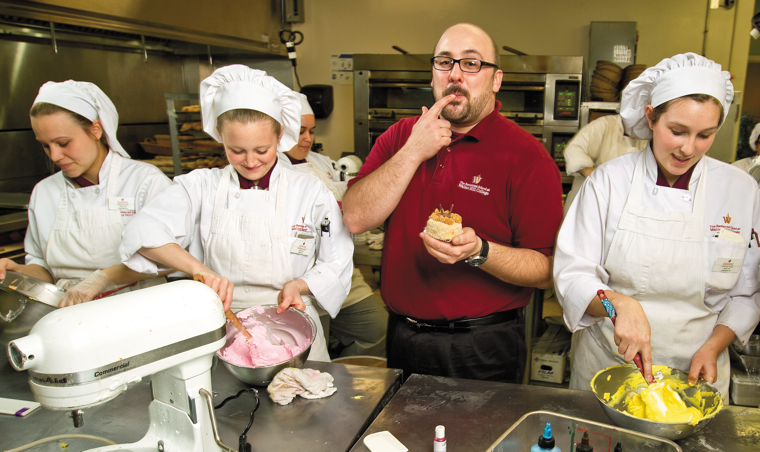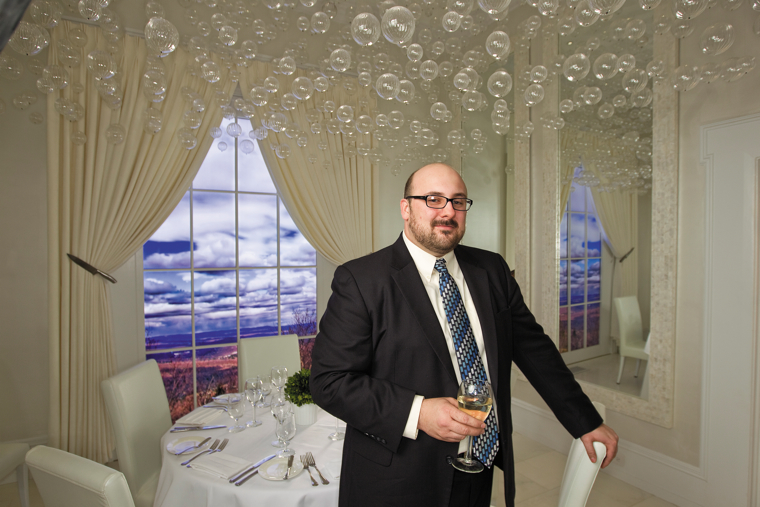Recipe for Success: How a Culinary School Uses Digital Signage to Engage Students

At a Glance
COLLEGE: The Restaurant School at Walnut Hill College
LOCATION: Philadelphia
FOUNDED: 1974
STUDENTS: 500 (mainly 18- to 22-year olds from Delaware, Maryland, New Jersey and Pennsylvania)
DEGREES: Associate and bachelor of science in culinary arts, pastry arts, restaurant management and hotel management
ABOUT: The country’s first private college to specialize in fine dining and luxury hospitality careers, the school offers an interactive educational experience in the University City district of Philadelphia, one of the most bustling urban collegiate environments in the nation. Many of its graduates begin their careers in managerial positions.
Mike Finnell has a straightforward approach to running technology programs at a culinary arts and hospitality college.
“If we’re going to teach hospitality, we have to preach hospitality,” says Finnell, IT coordinator of The Restaurant School at Walnut Hill College in Philadelphia.
To do that, Finnell works closely with college leaders, faculty and staff to integrate technology into every aspect of the student experience at school, which offers four degrees, in culinary and pastry arts, and restaurant and hotel management.
“The idea is to use technology to make everyone’s life easier,” Finnell says. “I want to make it so students aren’t working hard to find something. They’re simply trying to learn something.”
Nearly 30 Samsung digital signs, deployed throughout the campus, offer updates on daily culinary events, schedule changes and lifestyle information, and also provide directions around campus.
Using Samsung MagicInfo Pro software, the IT team and administrative staff can publish new content to the digital signs several times a day. MagicInfo Pro does not require any special bandwidth management because the updated content publishes to the screens only after a change is made — “as opposed to constantly streaming to them,” Finnell explains.
Plans also are under way to deploy a touch-screen information kiosk that will display interactive maps, making it easy for visitors to find their way around campus.
“The digital signs are really a fast and efficient way to get out information,” says Valery Snisarenko, the school’s director of marketing. “They are everywhere.”
Technology Is the Main Course in the Classroom and the Kitchen
All of the general education classrooms have Epson projectors. Plus, all six teaching kitchens have Lenovo notebooks mounted on adjustable arms that tether to Epson overhead projectors, which can display videos, websites and PowerPoint presentations, for instance.
The technology makes a tremendous difference in the learning experience, says Tom Tirendi, a chef instructor and 1998 graduate of The Restaurant School at Walnut Hill College.
"We have computers with Internet access right in the kitchen. It gives a lecture much more power."
“When I was in school, we had access to the Internet, but we had to go to the library,” he says. “Now, we have computers with Internet access right in the kitchen. We can look up recipes on the fly, and I can display my PowerPoint presentations. It gives a lecture much more power. Students can either view the lecture on the projector screen or follow along on their tablets. Everything is right at their fingertips.”
Jordan Fuller, a 23-year-old restaurant management major from Philadelphia, says all of the school’s technology makes the campus environment more appealing.
“The digital signs show prospective students coming to visit that we are a cutting-edge, modern campus,” he says. “It keeps people in touch and shows our capabilities.”
Buy-In from the Top-Down
"We're not afraid of technology."
A major reason for the school’s focus on using technology stems from the leadership of its president, Daniel Liberatoscioli. He’s always thinking up creative ways to deploy technology to make the campus hospitable to students and visitors alike, Snisarenko says.
A prime example? The coming use of displays for a spice and herb wall in the back hallway of the culinary building was his brainchild. Rather than let the high-traffic area serve solely as a route from class to class, Liberatoscioli suggested installing interactive kiosks and digital displays to make an effective and fun learning environment for students.
“I would have to say that the entire process of deploying the displays across campus has been much easier with his backing,” Snisarenko says. “Once people saw that he was such a strong advocate for the technology, just about everyone else got on board.”
She adds, “CDW’s help also made the whole experience pretty painless.”
Finnell credits CDW for bringing in technologists from its partner Samsung to discuss options for using digital displays, which really paved the way for all the unique uses of the technology on campus — from their deployment in hallways and stairwells to their use in instructional kitchens and restaurants.
“I just tell CDW I need ‘xyz,’ and they get me the technology I need.”
Working with CDW “really takes a load off of me,” Finnell says. “I don’t have to spend hours combing through Google for a part or searching the Internet to find out about the latest products. I just tell CDW I need ‘xyz,’ and they get me the technology I need.”
Mike Arbanas, the CDW account manager who worked closely with Finnell, says one of the keys to the project’s success was the selection of Samsung as the digital sign provider. The ease of use of Samsung’s MagicInfo management software was a big selling point, he says.
“I can’t tell you how many times we go down a path with a certain manufacturer and then have to retrofit in the middle of the project,” Arbanas says. “The Samsung displays met the initial requirements, met the price point they were looking for, plus offered the scalability and flexibility they need as their usage increases over time.”
Today's Students, Tomorrow's Hospitality Professionals

IT Coordinator Mike Finnell standing in front of four Samsung UE55 digital displays that form a video wall in The Restaurant School's Great Chef room.
Credit: Photography By Bill Cramer/Wonderful Machine
Integrating technology into the curriculum meshes well with the school’s overall approach to preparing students for work in the real world, Finnell says.
“One thing you have to understand is that the students are not learning in a sterile kitchen,” he says. “They are not just baking 50 rolls and throwing them out.”
Every class feeds off the work that a previous class completed, Finnell explains. The rolls that pastry students bake at 6 a.m. are organized by a production class in the early afternoon and finally served that evening by a restaurant operations class.
To immerse its students in a realistic culinary environment, the school has four working restaurants and a pastry café that are open to the public. A walk through the school’s entrance at the Allison Mansion brings visitors to the pastry shop and the Great Chefs of Philadelphia restaurant, which features fine dining. In the school’s atrium, a European-style piazza is home to the International Bistro, which serves world cuisine; the American Heartland, which offers steaks and fish; and finally, the Italian Trattoria.
“Working in the restaurants helps students get experience in the industry,” Finnell says. “We host a lot of events, weddings and private parties.”
The display technology plays an important role in helping the school and the students refine the many events with creative embellishments. For example, in the Great Chefs restaurant, four Samsung UE55 digital displays form a video wall that serves up content customized to each event.
“The technology lets us create dynamic environments that are related to the food being served,” Snisarenko says. “We can have it be whatever we want it to be, whenever we want it.” A vegetarian meal might have an agricultural backdrop, for example, while a fish or lobster dinner sports a tropical or seashore motif.
“Everyone here is dedicated to giving the next generation of chefs the tools and experiences they need to succeed.”
Fuller calls the video wall a great feature. “It changes through the course of the meal and, depending on the event that night, might give people the sense that they are dining in London or Paris.”
Along with the video wall in the Great Chefs restaurant, the school has deployed digital signs mounted in picture frames throughout the other restaurants and in all the reception areas, creating a video art gallery. Content can change daily via MagicInfo based on the day’s events.
“Our approach is very progressive,” Tirendi says. “We do meals for the public all week and have a great following in the neighborhood. Everyone here is dedicated to giving the next generation of chefs the tools and experiences they need to succeed.”








